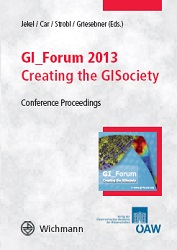
GI_Forum 2013, Volume 1, pp. 2-5, 2013/06/19
Creating the GISociety – Conference Proceedings

Scientists dealing with geospatial information usually work with huge sets of heterogeneous geographic data derived from different sources. Without a well-defined and organized structure they face problems in finding and reusing existing spatial data. Due to the increasing amount of collected data, the risk of data redundancy arises, which may cause data inconsistency, space issues and search difficulties. A spatial cataloguing system can facilitate a more efficient spatial data search as well as allowing data exchange with different institutions. Our proposed solution is implementing a spatial cataloguing system along with an automatic rule-based approach metadata generator that processes remote sensing data in Near Real Time (NRT) and simultaneously derives metadata. This paper will further describe how to extract the relevant metadata from the processed data and how we converted this heterogeneous metadata information into a common standardized format. A real-world scenario applied in The European Academy (EURAC) Research Institute for Applied Remote Sensing (IARS) illustrates the procedure of data processing and metadata generation.